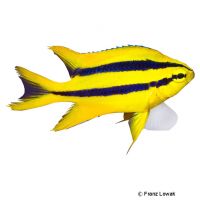Behn's Damsel (Neoglyphidodon nigroris)
| Behn's Damsel Neoglyphidodon nigroris | |
|---|---|
| Name | Behn's Damsel |
| Name Lat. | Neoglyphidodon nigroris |
| Family | Damselfishes |
| Family lat. | Pomacentridae |
| Order | Ovalentarias |
| Order lat. | Ovalentaria inc. sed. |
| Origin | Indo-West Pacific |
| Habitat | Coral reefs |
| Diet | Omnivore |
| pH | 8.1-8.4 |
| Hardness | 8-10 °KH |
| Behavior | Territorial |
| Keeping | Individual, group |
| Reef Compatible | Yes |
| Care Level | Moderate |
| Life Span | N/A |
| Protection | No |
| Metric Units | |
| Size | 8-13 cm |
| Temperature | 22-28 °C |
| Salinity | 33-36 ‰ |
| Aquarium | ~ 300 l |
| US Units | |
| Size | 3"-5" |
| Temperature | 72-82 °F |
| Salinity | 1.020-1.025 sg |
| Aquarium | ~ 80 gal |
Distribution and habitat
The distribution area of Neoglyphidodon nigroris is the western Indian Ocean and the western Pacific Ocean, where they occur from the Malay Archipelago to Vanuatu. There they live in the protected bays and reefs with rich coral growth.
Maintenance
They need a well-structured aquarium with a reef structure that allows for territoriality and at the same time offers hiding, resting and covering possibilities, with living stones that act like a biological filter and sufficient swimming space. Only lime-rich, heavy metal-free substrates may be used as substrate
Filters, skimmers and heaters are necessary to ensure water quality, as well as pumps to simulate tides, swells and bottom currents. Lighting must match the species-appropriate day-night rhythm of the animals
| Salinity: 33-36 ‰ | pH value: 8.1-8.4 |
| Carbonate hardness: 8-10 °KH | Nitrate content: 2-8 mg/l |
| phosphate content: 0.01-0.1 mg/l | nitrite content: 0.0-0.05 mg/l |
For salinity, an average value should be aimed for, which may only vary slightly by +/- 0.5 ‰. Ammonia and ammonium must not be measurable. Special attention must be paid to consistently good water quality and water values.
Diet
They feed mainly on zooplankton, but also need plant food. The feed change usually succeeds without problems. The food supply should consist of a commercially available, vitamin-enriched, frozen special food mix for plankton eaters or a combination of algae (e.g. spirulina, kelp) with live and frozen food, such as small mysis, krill, bosmids, cyclops and artemia. In addition, high-quality dry food in flake or granular form with a high vegetable content can be offered, which is usually well accepted. It is recommended to feed small portions several times a day (3-5 times).
Regular and varied feeding promotes health and increases resistance.
Behaviour and compatibility
It is recommended to keep them singly or in a group, a male with several females. To avoid territorial fights, they should be introduced into the aquarium at the same time. Adults can be territorial within the species. They should be socialized only with other, not too small and defensible fish.
Sex dimorphism
The males are usually larger and slimmer than the females.
Reproduction and breeding
There are isolated breeding reports about successful breeding in the aquarium. The male takes over the brood care and defends vehemently the brood.
Important
Juveniles have two longitudinal black stripes, adults are solid gray and exhibit increased territorial behavior.
It is recommended to keep these reef dwellers together with corals, especially acropores, and not in a fish-only aquarium.
If different species are kept together, care should be taken to ensure that the fish match each other in terms of water quality and temperature requirements and social behavior, and that the setup meets the needs of all species kept together. Newly introduced fish must be acclimated slowly to the water in the aquarium
Further literature can be found in your pet store.
References
Text: petdata; Image: Franz Lowak
Source: KUITER, DEBELIUS (2007): Atlas der Meeresfische: Die Fische an den Küsten der Weltmeere, Kosmos Verlag; ENGELMANN (2005): Zootierhaltung - Tiere in menschlicher Obhut: Fische, Verlag Harri Deutsch
- Gemäß § 21 Abs. 5 Tierschutzgesetz idgF
